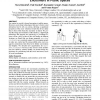Free Online Productivity Tools
i2Speak
i2Symbol
i2OCR
iTex2Img
iWeb2Print
iWeb2Shot
i2Type
iPdf2Split
iPdf2Merge
i2Bopomofo
i2Arabic
i2Style
i2Image
i2PDF
iLatex2Rtf
Sci2ools
CSCW
2016
ACM
2016
ACM
Jokebox: Coordinating Shared Encounters in Public Spaces
Eye contact is crucial to shared encounters in public spaces. However, most urban technologies that aim to foster social interaction tend to rely on screens, directing a significant proportion of the users’ attention towards the device rather than to those with whom the encounter is shared. We present the design and evaluation of the Jokebox, a lightweight technology that requires two passers-by to coordinate actions to hear a joke. In three in the wild studies at different locations we found that our design supported micro-level coordination in a consistent manner: by encouraging people to make eye contact and by using audible jokes, users engaged in interactions that often led to further conversation and laughter. We describe how opportunities for macrolevel coordination were key to the success of the installation, but varied by context. Finally, we present design implications for considering both the micro and macro levels of social coordination. Author Keywords Public display; c...
| Added | 01 Apr 2016 |
| Updated | 01 Apr 2016 |
| Type | Journal |
| Year | 2016 |
| Where | CSCW |
| Authors | Mara Balestrini, Raymundo Cornejo, Paul Marshall, Monica E. Tentori, Jon Bird, Yvonne Rogers |
Comments (0)

